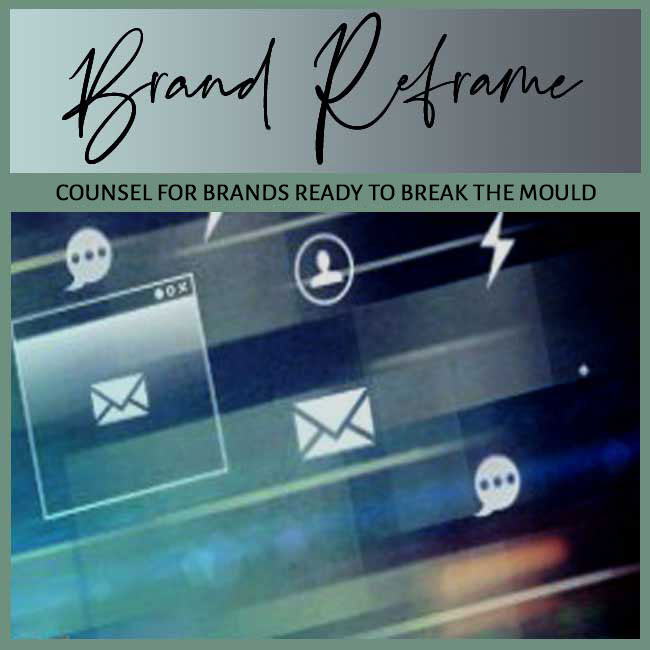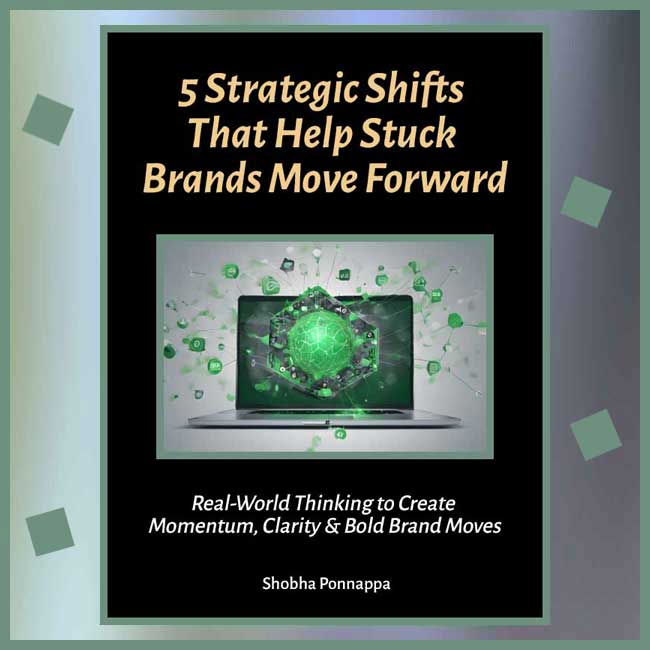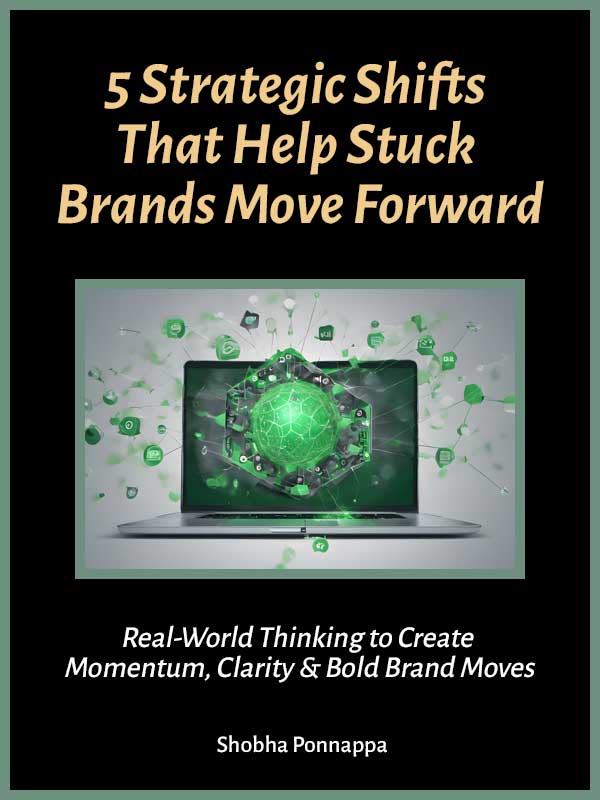
I have a passion for finding unconventional solutions to even the smallest challenges faced by my clients’ brands.
By embracing the unorthodox and thinking outside the box, I have consistently transformed seemingly insignificant hurdles into groundbreaking opportunities to craft a strategic BIG IDEA that sets their brand apart.
The beauty then lies in the seamless fusion of innovation and strategy, where each piece of content contributes to the overall narrative, amplifying the brand’s message in ways that resonate deeply with the audience.

I look for the smallest of a brand’s challenges that can become the seed of its breakthrough big strategic idea. I then convert this big idea into content campaigns or formats that can amplify the idea.
See the unusual solutions below that I have created for client brands from different industry sectors … most of the big strategic ideas came from an acute psychological understanding of the brand and its consumers and led to a spree of content ideas that went way beyond our wildest dreams.
These 14 case studies below are just a sample of the many more brands from different sectors that I have developed strategy and content for.
These case study examples reflect full-arc engagements—not just initial insights but deep partnerships across all five tiers of my work:
Remember … each client’s journey is unique. These samples are meant to inspire, not standardise.
CAVEAT: These case studies relate to clients who continue to work with me. Due to confidentiality, I am not disclosing their brand or business names or the specific names of their content campaigns (nor the phase they are at).
Unfortunately, this is a hurdle most independent consultants and freelancers face when they cannot transgress confidentiality to showcase their case studies with fuller disclosures. Nevertheless, I believe showcasing the content strategy difference and the executional innovations I bring to my clients is important.
I focus on twisting challenges into wins. I’d like to show you how I do that.

A leading car manufacturer came to me while going through a rough patch on a brand with less-than-acceptable engine performance levels. The brand was rapidly dropping off the consumer shortlist. Worse still, it was creating huge post-purchase anger being aired freely by buyers on social media.
Expectation management being one of the most important imperatives today, I was tasked with changing perceptions and getting irate consumers to understand the company’s concrete measures to set right the flaw. I was also asked to shape the mindset of those in the market for a car in that segment who were now confused and wary of the brand.
I started with a brand audit of the entire consumer experience before, during, and after the problem. The breakthrough came with the finding that the anger came more from the past love of the brand than the current hate of it.
When consumers have a deep emotional attachment to a brand, their expectations and loyalty are heightened significantly. They develop a strong bond based on positive experiences, trust, and a sense of identity that the brand represents for them.
As a result, when the brand experiences a decline in its standards or faces challenges, these devoted consumers feel personally affected.
Their emotional investment intensifies their disappointment and unhappiness as they perceive the brand’s decline as a letdown to their values and preferences. The feeling of a personal betrayal amplifies their negative reactions, leading to more intense and vocal expressions of dissatisfaction.
For these ardent brand enthusiasts, the connection is not merely transactional but deeply intertwined with their self-perception and aspirations, making any brand’s fall from grace a deeply personal matter.
By reshaping the content from this insight and with stories rooted in a big idea, brand enmity was turned once more toward brand advocacy.
I leveraged the profound understanding of consumers’ emotional connections to the brand and acknowledged their grievances. I devised a BIG IDEA: it was to reconnect consumers with the heart of our brand. This led me to reshape the way the brand communicated with its audience.
Instead of dismissing or ignoring the negative feedback, I addressed it openly, demonstrating empathy and transparency. I showcased the brand’s history of excellence, highlighting how the engine performance flaw was an anomaly, not a representation of its overall legacy.
Here are 10 of the most interesting ideas I brainstormed for this brand (among many others). Several of these ideas have made the final cut.
A Test Drive Challenge Event: Organize a nationwide Test Drive Challenge to allow potential buyers to experience the brand’s latest and improved engine performance firsthand. Capturing and sharing their reactions and feedback through social media and video content would be the plan.
An Engineer Spotlight Blog Series: Involve the brand’s engineering team members in blogging about how they identified and addressed the performance flaw. This could highlight their dedication, expertise, and passion for delivering high-quality products.
A Brand Redemption Podcast: Set up a podcast series where industry experts, automotive enthusiasts, and influencers are invited to discuss the brand’s journey towards redemption. The platform could help share insights into the brand’s future roadmap.
A Consumer Support Forum Community: Establish an online community forum where consumers could engage with each other and the brand’s representatives to share success stories of those who had experienced the brand’s commitment to improvement.
A Road to Trust Ad Campaign: Develop a series of emotionally charged advertisements that can tell the brand’s story of resilience, learning from mistakes, and rebuilding trust.

A skincare brand with mildness as its core value was struggling to gain traction for its range of products in the online world. In fact, the harder the brand tried to message its audiences with vigor, the worse things seemed to become. I was asked to look into what could be going wrong.
I started by looking into the brand strategy. But there was nothing there that I could pinpoint as a cause for the failure of the brand to take off. When I did a deeper analysis of the execution of the brand strategy, however, it showed me how schizophrenic the brand really seemed.
As a skincare brand, its content had to carry all its gentle values the brand promised – but, instead, the brand was aggressively chasing eyeballs online. The content tone of voice was going against the softer attributes and the key positioning of the brand. It was leaving consumers more uncomfortable than engaged.
Brands, much like individuals, are defined not just by what they say but by how they say it. The essence of a brand is captured in its positioning – the unique space it occupies in the minds of the consumers.
For a skincare brand that positions itself on the platform of ‘softness,’ the expectation is that everything about it, from its product offerings to its communications, exudes a sense of gentleness, care, and serenity.
When there is a divergence between this expected demeanor and the tone of the brand’s content, it creates cognitive dissonance for the consumer.
In a world flooded with choices, consumers yearn for brands they can trust, and trust is built on consistency.
A “schizophrenic” brand personality disrupts this trust and dilutes its equity, making it harder for consumers to connect or feel loyal to the brand.
The journey to mend the dissonance between the brand’s positioning and content required meticulously recalibrating content strategies and messaging.
Recognizing that authenticity and consistency are the bedrock of brand trust, I conducted a rigorous introspection to align the brand’s external communications with its core values.
My BIG IDEA wasn’t merely about toning down the aggressiveness; it was about capturing the essence of ‘softness’ and weaving it organically into the content for every touchpoint.
By revisiting the narrative and fostering genuine, meaningful conversations, the brand was repositioned not as a distant advertiser but as a trusted companion in the skincare journey, sparking profound and purposeful engagement.
By reshaping the content from this insight and with stories rooted in a big idea, brand enmity was turned once more toward brand advocacy.
I leveraged the profound understanding of consumers’ emotional connections to the brand and acknowledged their grievances. I devised a BIG IDEA: it was to reconnect consumers with the heart of our brand. This led me to reshape the way the brand communicated with its audience.
Instead of dismissing or ignoring the negative feedback, I addressed it openly, demonstrating empathy and transparency. I showcased the brand’s history of excellence, highlighting how the engine performance flaw was an anomaly, not a representation of its overall legacy.
Here are 10 of the most interesting ideas I brainstormed for this brand (among many others). Several of these ideas have made the final cut.

A beloved coffee brand faced a conundrum when it had to transition from oflline to online sales. It had built a reputation on the tangible warmth of its cafes—where every wooden table bore witness to countless conversations, and every cup symbolized a bond. Translating this tactile essence to the online realm, where interactions were primarily through screens and clicks, was a monumental task.
Further, while the digital landscape offered expansive reach, it also came with a cacophony of competing voices. The coffee brand had to recreate its unique ambience online and ensure its voice remained distinct and audible amidst the digital din.
In my deep dive into the brand’s essence and its loyal consumer base, I stumbled upon a breakthrough insight. The core appeal of the coffee brand was never solely about the physical space of the cafes or the rich aroma of freshly brewed coffee. At its heart, the brand’s allure was the sense of community and connection it fostered.
In today’s digital age, while the platforms for connection have shifted, the fundamental human desire to bond and share experiences remains unchanged. Social media, in essence, serves as the modern-day café – a space where stories are exchanged, memories are shared, and bonds are forged.
It became evident that the digital realm, with its vast interconnected networks, offered an even more expansive ‘café’ space waiting to be tapped into by the brand.
Understanding this parallel between cafes and online platforms provided a clear roadmap for digital relevancing. Online consumer behavior further validated this insight.
Users often gravitate towards content that evokes emotion, fosters community, and offers a sense of belonging. They seek spaces—digital or otherwise—that resonate with their identities and experiences. Brands that manage to create such spaces online see higher engagement, loyalty, and advocacy.
Thus, by positioning the brand as a digital curator of coffee-driven communities and conversations, it was possible to authentically extend its offline essence into the online world, ensuring its voice remained not just distinct but deeply resonant.
For the coffee brand’s digital relevancing, my content strategy pivoted around the foundational principle… a BIG IDEA of “translating ambience into engagement.”
Recognizing that the physical allure of the cafes couldn’t be directly replicated online, we instead focused on encapsulating the emotional essence that drove patrons to those spaces: connection, warmth, and shared experiences.
The strategic change in direction sought to metamorphose the brand from a mere purveyor of coffee into a digital curator of stories, memories, and bonds, using coffee as the connective thread.
By leveraging platforms as virtual gathering spaces, my aim was to recraft the online brand narrative, ensuring that each digital interaction mirrored the intimate, familiar feeling of a coffee chat, making the brand not just seen or heard but genuinely felt in the vast digital realm.
Here are 10 of the most interesting ideas I brainstormed for this brand (among many others). Several of these ideas have made the final cut.

Nestled in a local community, a beer brand was a byword to generations of brewing mastery. However, with time, its legacy became a double-edged sword. While still commanding loyalty from its older patrons, it also faced stagnation with its outdated equipment struggling to produce at scale. Escalating costs per bottle and the narrow clientele were insufficient to stay out of the red.
Additionally, the digital era brought a new consumer segment into the fray: Gen Next. The beer brand couldn’t afford to ignore this largely online audience. But bridging the gap by catering to the new generation, without alienating the old, and doing so in a way that optimized costs and expanded reach was a double challenge.
Diving deep into extensive market research, customer feedback sessions, and global beer industry trends, a discerning dichotomy began to emerge. I noticed that Gen Next exhibited an innate desire for authenticity, yet they consumed most of their content and experiences in the digital space.
This group wasn’t merely looking for a product; they were in search of stories, experiences, and connections.
The realization hit that the essence of old beer wasn’t just its brew but its rich narrative. This was the first pivot insight: the beer brand needed to transpose its legacy into a digital medium that resonated with this younger audience, making the age-old stories accessible and relatable to them.
The second pivot centered on the method of this digital transition. While many brands were moving online with direct product promotions, it became evident that Gen Next was more invested in content that evoked emotions, told stories, and fostered communities.
They didn’t just buy products; they bought into narratives and what those narratives represented. This realization led to the embracing of content marketing as the tool of choice.
Instead of mere advertisements or standard ecommerce, the beer brand needed a repository of digital content – stories, documentaries, user-generated content, and more – that showcased its history, its process, and its community.
In this double pivot, the brand would not only digitize its legacy but do so in a manner that crafted compelling, engaging, and shareable content, ensuring it became a staple in the online conversations of Gen Next.
The overarching content strategy I created for this brand – my BIG IDEA – revolved around encapsulating its rich legacy within the vibrant tapestry of the digital age.
Recognizing that the brand’s strength lay in its deep-rooted stories and traditions, the strategy aimed to channel this narrative strength into a medium that resonated with Gen Next.
Instead of a traditional marketing approach that focused on product-centric promotions, the pivot prioritized immersive storytelling, fostering community, and creating shared experiences. The intent was to craft a digital space where old-world charm seamlessly blended with contemporary sensibilities.
By leveraging content marketing, I wanted the brand to aim to inform, engage, inspire, and build lasting relationships with a younger audience, ensuring that its legacy was preserved and thrived in this new era.
Here are 10 of the most interesting ideas I brainstormed for this brand (among many others). Several of these ideas have made the final cut.

An airline brand, once a frontrunner in a small East European country’s aviation landscape, found itself confronting an unexpected downturn in customer interaction and ticket sales. Boasting a formidable fleet, low pricing, and an extensive web of routes, everything ostensibly indicated they should be leading the market.
Their content marketing campaign highlighting “connected journeys” was aimed to highlight their network of routes and operational excellence. Yet, in spite of the campaign’s precision and quality, an intangible gap remained. Feedback loops and engagement metrics hinted at some elusive element the brand might have overlooked.
I started my connection with the brand by delving into the underlying factors of its issues. A series of in-depth customer feedback sessions, online sentiment analyses, and industry trend observations were initiated.
What emerged was a revelation: while modern travelers acknowledged the importance of reliable connectivity and seamless flights, their emotional connection to travel revolved around experiences, adventures, and memories. The magic wasn’t just in getting from Point A to Point B but in the allure of Point B itself – the destinations.
Stories of sunrises over unfamiliar skylines, culinary adventures in bustling local markets, or serendipitous encounters in a foreign land were what truly resonated.
From the customer’s lens, an airline isn’t merely a mode of transportation but a bridge to these experiences. The story of a traveler begins long before boarding the plane; it commences with the dream of a destination, the anticipation of an experience.
By focusing on the technicalities of routes and connections, the airline brand had inadvertently positioned itself as just another step in the logistical process, rather than an integral part of the dream.
Recognizing this disconnect was crucial. For this airline brand to recapture its audience’s imagination, shifting the content emphasis from the mechanics of flying to the magic of traveling was imperative.
I ensured the essence of the content strategy of this airline brand underwent a transformative shift, placing the spotlight squarely on the emotive allure of travel.
My BIG IDEA for the brand was that the heartbeat of any journey isn’t limited to its logistical aspects – and the approach has to transition from showcasing the mere act of flying to encapsulating the wonders and sentiments associated with reaching one’s destination.
This meant moving beyond the tangible – the routes, aircraft, and schedules – and delving into the intangible – the dreams, the excitement, the memories.
This revamping of content direction was all about aligning with the heartstrings of travelers, positioning the airline not just as a carrier, but as a custodian of dreams and experiences, guiding passengers towards new horizons and adventures.
Here are 10 of the most interesting ideas I brainstormed for this brand (among many others). Several of these ideas have made the final cut.

A bank brand was grappling with a significant challenge in its home loan marketing efforts. The bank’s one-size-fits-all approach, which was envisioned to appeal to a wide audience, failed to gain traction with the diverse range of potential homebuyers. The underlying problem was not just the generic representation but also the bank’s uncertainty on how to effectively segment the market.
Without a clear understanding of the diverse motivations, backgrounds, and financial considerations of different buyer groups, the bank risked alienating potential customers and ceding ground to competitors who could better address these micro-segments. The challenge was twofold: abandon the broad-brush approach and decipher the puzzle of market segmentation.
My quest to uncover the ideal market segmentation for the bank was both a challenging and enlightening process. Early on, an invaluable insight emerged: it became abundantly clear that our market segmentation couldn’t be a mere demographic split; it needed to revolve around life stages.
This realization was pivotal, transforming the entire perspective on how we approached our potential home buyers. Grounding our segmentation in life stages was the ideal approach for multiple reasons.
Firstly, life stages encapsulate a range of emotional, financial, and practical needs that are intrinsically linked to home buying. A newlywed couple just starting their journey might prioritize a starter home close to urban amenities, whereas a family with teenage children might seek larger spaces and proximity to schools.
On the other hand, empty nesters might be looking to downsize or move to quieter locales. By segmenting based on life stages, we could craft messages, offers, and services that directly addressed the unique aspirations and challenges of each group.
Further, focusing on life stages would allow the bank to anticipate and cater to evolving customer needs. As individuals transition from one life stage to another, their requirements shift.
Recognizing this fluidity would enable the bank to meet immediate needs and position itself as a lifelong partner for customers, accompanying them through various milestones.
This approach promised a deeper connection and enhanced trust, as customers would see the bank not as a mere transactional entity but as a brand that truly understands and grows with them.
My content strategy – a BIG IDEA – for the bank was to pivot away from offering different loan products, to accompanying customers through the myriad chapters of their lives.
By identifying and understanding these life stages, the content tailored its messaging to echo the dreams, concerns, and aspirations unique to each phase, whether it was the excitement of a first home for newlyweds, the expansion needs of a growing family, or the downsizing considerations of empty nesters.
More than just emphasizing the financial aspects, the strategy highlighted the bank’s commitment to being there at every key moment, offering guidance, support, and tailored solutions.
In essence, the bank had to transition from being a mere loan provider to a lifelong partner, walking hand in hand with customers through their home-buying journey.
The strategy was more than just business; it was about nurturing relationships and building trust that spans lifetimes.
Here are 10 of the most interesting ideas I brainstormed for this brand (among many others). Several of these ideas have made the final cut.

A renowned maternity and pediatric hospital, boasting both a storied legacy and state-of-the-art facilities, found itself in unfamiliar territory. For all its medical prowess and commitment to patient care, a vexing problem persisted. Feedback loops, both formal and informal, from their most critical audience – expectant and new parents – pointed towards an unsettling disconnect.
Instead of feeling reassured, informed, and connected, these parents felt distant from the hospital’s messaging. The brand’s digital channels, too, reflected a similar story with dwindling engagement rates and less-than-stellar feedback. The hospital, renowned for addressing complex medical challenges, found itself wrestling with a question: Why was their content failing to resonate with the very community they sought to support and nurture?
In my task to uncover the root of the hospital’s branding conundrum, I delved deeply into both qualitative and quantitative data. I initiated focused group discussions with expectant and new parents, analyzed feedback from various touchpoints, and reviewed engagement metrics in detail.
Amidst the wealth of information, a pattern began to emerge: parents were seeking more than just medical expertise. They craved an emotional connection, a sense of understanding, and a journey that paralleled their own transformative experience of parenthood.
The hospital’s content, though informative, felt too transactional and lacked the human touch.
From a customer’s perspective, the transition into parenthood is not just a medical event but an emotional odyssey filled with excitement, anxiety, hope, and vulnerability. Parents-to-be needed a brand that echoed their sentiments, validated their concerns, and offered guidance as a trusted companion.
By focusing solely on clinical excellence, the hospital was missing out on capturing the emotional essence of this journey. It became clear that for the hospital to truly connect and provide value, it needed to resonate not just with the minds of its audience, but more importantly, with their hearts.
The strategy had to be reframed from a mere service provider to a partner in the profound journey of parenthood.
Recognizing the emotional depth of the journey into parenthood, my content strategy – my BIG IDEA – for the hospital underwent a significant shift in direction. I decided to follow a content strategy that I termed as a “parenthood partnership pathway.”
Instead of merely highlighting the hospital’s medical capabilities, the strategy was shifted towards embracing and reflecting the myriad emotions, aspirations, and concerns of expectant and new parents.
The emphasis was on creating content that spoke to the heart, fostering a genuine bond between the hospital and its community.
By placing the experiences and emotions of parents at the forefront, the brand’s narrative could be transformed from being clinical to become more compassionate about the life-changing voyage of bringing new life into the world.
Here are 10 of the most interesting ideas I brainstormed for this brand (among many others). Several of these ideas have made the final cut.

A telecom brand, found itself ensnared in a perplexing situation. With a robust infrastructure under its belt and substantial investments channeled into new cutting-edge marketing initiatives for its multiscreen customers, the brand had every reason to anticipate resounding success. But engagement was tepid, and surveys revealed a recurring sentiment of ambivalence among subscribers.
Testimonials and feedback echoed a shared sentiment of the brand’s message not resonating as intended. The management and the marketing team were left scratching their heads, trying to decipher this enigma. The telecom brand stood at a crossroads, fully aware of the urgent need to change strategy but uncertain about the underlying reasons for their challenges.
During my deep-dive analysis of the brand’s content dissemination and audience engagement metrics, I stumbled upon a recurring pattern: customers were accessing content across multiple devices but seldom engaging with it holistically on any single platform.
This behavior suggested that while they were receiving the brand’s message, it wasn’t being tailored to their multiscreen consumption habits. Eureka! The brand’s content wasn’t inherently flawed, but its delivery was out of sync with today’s digital user behavior.
From the customer’s perspective, this insight was pivotal.
In today’s fast-paced digital age, consumers expect seamless interactions with brands, irrespective of the device they are on. They want content that’s not only relevant but also cognizant of their platform-specific behaviors and expectations.
A video that works on a TV screen might not have the same impact on a smartphone, just as an infographic perfect for desktop viewing might be ill-suited for a tablet.
Recognizing and acting on this multiscreen reality meant acknowledging and respecting the customer’s evolving digital consumption patterns, and thus enhancing their overall brand experience.
For the telecom brand, a newly envisioned content strategy – my BIG IDEA – centered on the art of sequential storytelling across multiple devices. Each device served as a unique chapter in the brand’s overarching tale. The brand could either air its own story – or become the sponsor of stories created by others. The basic idea would be to showcase the brand’s ability to reach audiences and engage them across-devices.
Smartphones could kick off the story, introducing viewers to the initial context. Tablets could delve deeper into the complexities and character developments, while laptops could expand on subplots and provided a richer, detailed exploration.
The climax and resolution could be masterfully presented via smart TVs, offering a satisfying conclusion. Such a multi-device narrative approach could transform the once-perceived challenge of multiscreen browsing into an engaging and immersive brand journey.
By tailoring content to each device’s strengths, the brand could not only optimize the user experience but also foster a deeper connection with its audience, encouraging them to seamlessly transition through every narrative touchpoint.
Here are 10 of the most interesting ideas I brainstormed for this brand (among many others). Several of these ideas have made the final cut.

A healthcare brand had a problem … despite holding a top-tier position in the realm of diabetic thought-leadership and boasting of advanced treatments and unparalleled expertise, their content strategy seemed to misfire. Their educational and informative content, designed with the intent to guide and empower their audience, was barely making a mark in terms of engagement.
This was particularly alarming as it threatened their esteemed status of being the go-to authority in diabetes care. With a fervent desire to retain this thought-leadership position, the brand was in dire need to decode the riddle of their messaging not resonating as intended with diabetics or their families.
As I delved into the depths of the brand’s existing content, I began to analyze the feedback loops, comment sections, and various other consumer engagement metrics.
An immersive research phase led to shadowing some of the primary audience members, understanding their daily routines, their challenges, and their moments of triumph in managing diabetes.
What surfaced was an evident disconnection; while the brand was extensively focusing on the clinical aspects of the disease, the real-life, everyday struggles of a diabetic person were somewhat overlooked.
From the customer’s vantage point, managing diabetes wasn’t solely about medication or clinical directives; it encompassed a universe of adapting lifestyles, navigating social settings, managing eating times, and even travel preparations.
Diabetics yearned for a more holistic approach to content, which didn’t just stop at medical guidelines but extended into embracing a more enriching, balanced life despite the ailment.
The brand’s prior approach, although informative, lacked this humane touch, making it imperative to pivot the content strategy to resonate more deeply with the lived experiences of those battling diabetes daily.
For the healthcare brand, the strategic shift I recommended – my BIG IDEA – was geared towards a comprehensive and empathetic understanding of diabetes management.
Instead of narrowly focusing on medical advisories, I proposed that the content embrace the nuances and intricacies of daily life for those living with diabetes.
This encompassed incorporating interesting recipes and diets tailored for diabetic needs, practical advice on managing eating schedules, insights on safely integrating sports and physical activity, guidelines for navigating social interactions without compromise, and tips for hassle-free travel experiences.
The goal was to move from a solely clinical voice to one that echoed the everyday realities and aspirations of those with diabetes.
In doing so, the brand wouldn’t just inform but also inspire, reaffirming its position as a thought leader while becoming an invaluable guide in the day-to-day lives of its audience.
Here are 10 of the most interesting ideas I brainstormed for this brand (among many others). Several of these ideas have made the final cut.

In the fiercely competitive world of instant foods, a certain brand had once occupied a lofty position, recognized for its taste and convenience. Yet, as competitors flooded the market with similar offerings, the distinctiveness of that brand began to wane. They were deeply focused on promoting their diverse food varieties, believing this would be their unique selling proposition.
However, consumers started viewing their offerings as just another option in a cluttered space. Despite the concentrated efforts to emphasize their wide range of dishes, the brand’s content felt drowned in a sea of comparable narratives. This dire situation left the brand grappling with a vital question: How could they recapture the consumer’s imagination and distinctively stand out in such an overcrowded marketplace?
Amidst the bustling aisles of a supermarket, I paused to observe customers as they navigated through the maze of instant food choices. It wasn’t just hunger that drove them but a myriad of needs – time constraints, convenience, and the desire to continue with their day without culinary interruptions.
As a sports fan beside me raved about the night’s big game, a young mother discussed the latest binge-worthy show with her friend, and a teenager debated the merits of a new video game release.
The insight dawned upon me: for these consumers, instant food wasn’t just about quick meals; it was about ensuring they had more time to indulge in what they loved.
It was vital to bridge this insight into the brand’s strategy.
The consumers weren’t solely looking for a tasty meal in minutes. They sought a solution that would free them up to pursue their passions, be it sports, music, gaming, or any other interest.
The food was a means to an end, not the end itself. For the brand to regain its allure, it needed to not just emphasize the variety of its dishes but underscore how its products enhanced the overall experiences of its consumers’ lives.
This shift would allow the brand to reposition itself as not just a provider of meals, but a facilitator of moments, enriching their daily experiences.
In addressing the instant food brand’s conundrum, the overarching content strategy I gave them – my BIG IDEA – shifted from solely emphasizing the product to celebrating the broader experiences it facilitates.
Recognizing that the brand’s offerings were not just about satiating hunger, but about enriching the moments they accompanied, the strategy transitioned to position the brand as an enabler of passions.
Instead of primarily showcasing the variety and taste of the dishes, the content began to weave narratives around how the brand’s products seamlessly fit into consumers’ dynamic lives, complementing their myriad interests, be it sports, binge-watching, reading, or gaming.
The brand, through its revised content, aimed to resonate on a deeper, more emotional level, underlining its role in elevating everyday moments and interests.
Here are 10 of the most interesting ideas I brainstormed for this brand (among many others). Several of these ideas have made the final cut.

In the vital area of public health messaging, a nonprofit brand had built a reputation over the years for its relentless fight against smoking. With a rich history of advocacy and numerous campaigns under its belt, the organization was no stranger to the challenges of anti-smoking endeavors. However, in recent times, their messaging had begun to lose its impact. Audience engagement dwindled.
Younger generations appeared to perceive their campaigns as clichéd and out-of-touch. The market was flooded with anti-smoking messages from various sources, making it even harder for their voice to stand out. This posed a dilemma for the nonprofit: how to reinvigorate their messaging to not only be heard but to truly resonate and incite change among a new generation.
Diving deep into the challenge, I initiated a comprehensive analysis of both the content the nonprofit brand had previously produced and the current audience reactions.
What stood out was a noticeable gap between the brand’s earnest intentions and the perception of the younger demographic. Several feedback sessions with this group revealed a key insight: today’s youth didn’t necessarily dismiss the importance of anti-smoking messages; instead, they were seeking a more relatable context.
The traditional scare tactics and morbid imagery that once worked had now become background noise in their media-saturated lives.
The messaging that had worked with a previous generation didn’t work with Gen Next. These younger audiences were more likely to engage with narratives that resonated with their daily experiences and emotions.
They sought authenticity, relatability, and a touch of humor or irony in the content they consumed. The repetitive emphasis on the ill-effects of smoking was acknowledged but had become predictable “old hat.”
It was evident that if the nonprofit wanted to truly penetrate this audience’s consciousness, the messaging needed a fresh twist, rooted in genuine understanding and empathy towards this generation’s context.
Recognizing the evolving content consumption patterns and the quest for relatability, my strategic shift – my BIG IDEA – for the nonprofit brand was to move away from traditional anti-smoking campaigns. Instead, I envisioned a campaign that mirrored the myriad moments in life when individuals express a need for change, uttering sentiments like “That’s it, I quit!”
Whether it was the grind of a taxing job, the weight of a toxic relationship, or even the inertia of an uneventful routine, there are countless scenarios where people feel cornered and yearn to proclaim, “That’s it, I quit!”
By juxtaposing the act of quitting smoking with these universal moments of exasperation, frustration, or renewal, the intention was to create a more expansive, emotionally-charged narrative.
This new direction was not just about the harms of smoking, but rather a celebration of the human spirit’s resilience, adaptability, and the continuous journey towards better choices.
In essence, the content strategy aimed to connect the act of quitting smoking with broader life aspirations, making it a part of a holistic pursuit of well-being and self-improvement.
Here are 10 of the most interesting ideas I brainstormed for this brand (among many others). Several of these ideas have made the final cut.

A home decor brand, renowned for its exquisite home furnishings, found itself at a critical juncture. While they had an array of quality products, their limited number of physical stores and the vast geographic spread of their potential customers put them at a significant disadvantage. The era of online shopping was booming, but their clientele, particularly those investing in home decor, often preferred to physically experience the products before making a purchase.
This tactile need to ‘feel’ the texture, witness the colors firsthand, and visualize the products in their spaces made many hesitant to buy online. The brand was in a dilemma. They needed to cater to the modern shopper while respecting the traditional sensibilities of home decor enthusiasts.
While conducting a comprehensive market analysis and consumer behavior study, I stumbled upon a notable pattern. Digital shopping had undeniably reshaped the retail landscape, but in the realm of home decor, the sensory experience – feeling the texture of a fabric or perceiving the true color of a curtain – still held significant value.
Simultaneously, in informal discussions with potential customers, a recurring sentiment emerged: many were hesitant to buy online due to concerns about product mismatches or regret over not physically seeing the options beforehand. They wanted more than just pictures; they craved a personal interaction and firsthand experience with the product.
From the customer’s viewpoint, home decor was not merely a transaction; it was an emotional investment into creating a space that resonated with their personality and comfort.
To them, the assurance that they were making the right choice was crucial. The tactile experience of products played a pivotal role in shaping that confidence. It was clear that while the brand needed to pivot to online sales to reach a broader audience, it also had to provide a unique solution that addressed this sensory gap.
The blend of physical experience and online convenience had to become the cornerstone for strategy reformation.
My content strategy – my BIG IDEA – for the home decor brand was to do a transformative shift, marrying the best of both online and offline worlds.
Recognizing the increasing dependence on digital exploration, the brand could transition from a solely brick-and-mortar presence to a hybrid strategy. Online, we could introduce tools like augmented reality, allowing customers to virtually experience and position furnishings within their homes.
This digital immersion could be complemented offline with a “sample-at-home” service, ensuring that the tactile and tangible essence of home decor shopping wasn’t lost.
The synergy of these approaches meant that customers could seamlessly transition between the digital realm and the physical world, experiencing products in a holistic manner.
This fusion ensured the brand remained aligned with modern shopping behaviors while staying rooted in traditional shopping values.
Here are 10 of the most interesting ideas I brainstormed for this brand (among many others). Several of these ideas have made the final cut.

In the saturated landscape of online tools, a SaaS brand emerged with a distinct proposition: a streamlined CRM system designed specifically for small to medium-sized enterprises. Its promise was unmistakable – agility, cost-effectiveness, and an uncomplicated user experience. The brand’s content strategy was meticulously built around the allure of their CRM’s simplicity in juxtaposition with the intricacies of heftier platforms.
However, beneath this straightforward pitch, a deeper issue began to surface. While leads were being generated, the conversion rates to actual sales were not meeting expectations. This put the brand in a quandary, questioning whether their emphasis on simplicity was inadvertently overshadowing the product’s comprehensive capabilities.
As I delved deeper into the situation, I decided to step into the shoes of our potential clientele. Through a series of one-on-one interactions, feedback sessions, and market surveys, I unearthed a recurring sentiment.
Businesses were attracted to the promise of simplicity, but were apprehensive about the CRM’s ability to scale with their evolving needs. The emphasis on being a “small” solution inadvertently conveyed limitations.
The prevailing perception was that the brand, with its emphasis on simplicity, might not be robust enough for a business that grows and diversifies. This was the missing link: while we were winning them over with ease of use, we were losing them with the unintended message that our product might not be future-proof.
From the customer’s perspective, adopting a CRM is a significant commitment, both in terms of time and resources.
For a small to medium-sized business, the decision becomes even more crucial. They’re looking for a solution that not only fits their current needs but also remains relevant as they expand and face more complex challenges.
Customers needed assurance that the brand wasn’t just a temporary solution but a long-term partner. By honing in on this insight, it became clear that our content strategy needed a recalibration.
We had to strike a balance in our messaging, emphasizing not just the simplicity and ease-of-use, but also the adaptability and depth of our CRM solution.
For this SaaS brand, my content strategy – my BIG IDEA – recommended a shift in focus from mere simplicity to a harmonious blend of simplicity and scalability.
Recognizing the nuanced demands of our target audience, we tailored our messaging to underscore the CRM’s adaptability alongside its user-friendly features.
The intention was to craft a narrative that showcased the CRM as a solution that not only catered to the immediate needs of small to medium-sized businesses but was also a reliable partner in their growth journey.
This strategic redirection was not merely about altering our promotional content; it was about reshaping our brand’s story, ensuring it resonated deeply with our audience’s aspirations and future ambitions.
Here are 10 of the most interesting ideas I brainstormed for this brand (among many others). Several of these ideas have made the final cut.

An athletic gear brand had always celebrated the raw passion and commitment of individual runners. Their campaigns poignantly showcased the sweat, discipline, and exhilaration of runners training diligently and achieving their personal bests. While initially successful, over time, the brand noticed dwindling engagement with their campaigns.
They found themselves in a saturated market where several competitors were also heralding the personal triumphs of runners. The brand faced a perplexing conundrum: How could they reinvigorate their brand messaging to stand out and deeply resonate with their audience in a crowded marketplace?
While diving deep into the evolving psyche of the modern consumer, I observed an intriguing shift. Beyond just the individual pursuit of athletic milestones, there was a growing trend towards communal experiences and activities that served a greater purpose.
People weren’t only running for personal bests; they were running to make a statement, to support causes, and to bring about tangible changes in society. This sentiment echoed in the market trends as well: athletic gear emblazoned with purpose statements or cause-related themes saw a noticeable spike in sales.
It was evident that consumers were not just buying apparel; they were buying into a mission, an ethos.
From the customer’s viewpoint, this shift was monumental. Athletic pursuits were no longer just about individual accomplishments; they had become platforms for advocacy, solidarity, and tangible change.
By participating in runs for causes, customers felt a dual sense of achievement: the personal satisfaction of completing a run and the larger gratification of contributing to a meaningful cause. Moreover, wearing gear that resonated with their purpose was like wearing their hearts on their sleeves, providing them an added layer of identity and pride.
For the brand, understanding and aligning with this evolving consumer sentiment wasn’t just about staying relevant; it was about forging deeper, more meaningful connections with its audience.
For the athletic gear brand, my content strategy – my BIG IDEA – was to make a significant directional shift.
The strategy transitioned from solely spotlighting personal achievements to emphasizing the collective power of running for causes.
Initially, our narratives were firmly grounded in celebrating individual athletic accomplishments, highlighting the endurance and dedication of runners. However, as we honed in on the rising trend of community-driven causes and the consumer’s inclination towards purpose-driven athletic pursuits, we pivoted.
By doing so, we aimed to resonate more deeply with our audience’s evolving values and aspirations.
The brand found its sweet spot by intertwining their personal athletic journeys with larger societal missions and narratives.
Here are 10 of the most interesting ideas I brainstormed for this brand (among many others). Several of these ideas have made the final cut.
Delve deeper into the tangible results of my unique approach by exploring my service spectrum, my case studies, and other items in my portfolio. Each piece is a testament to the harmony of experience, an unconventional mindset, and cross-sector adeptness.
If you’re eager to elevate your brand’s narrative and strategy, don’t hesitate to tap into this wealth of knowledge.

"One BIG IDEA can turn brand stagnation into unstoppable movement. Spots are limited each week—book your breakthrough session now."
Shobha Ponnappa
I Bring You:
Smart insights, real-world frameworks, and idea-driven clarity – designed to help brands move.
Get my fortnightly Brand Reframe newsletter. Smart insights, distilled thinking, and focused momentum to help your brand lead.

Get my free case studies guide. Practical ideas, bold shifts, and clever transformations to propel your brand forward.

Just fill in the form to join. Get my newsletter and the guide shown alongside, all with several game-changing tips.
KEY TOPIC CATEGORIES COVERED ON THIS SITE:
BRAND STRATEGY MISFIRES
BRAND DIFFERENTIATION ISSUES
BRAND TIMING MISTAKES
BRAND ALIGNMENT CHALLENGES
BRAND POSITIONING GAPS
BRAND CONTENT INCONSISTENCY
BRAND LEGACY UNDERUSE
BRAND AUDIENCE DISCONNECT
BRAND DIGITAL STAGNATION
BRAND MESSAGING MISFITS
BRAND LEADERSHIP GAPS
BRAND PURPOSE CONFUSION
BRAND METRICS MISREADING
BRAND VISUAL IRRELEVANCE
BRAND POSITIONING OVERLOAD
BRAND FUNNEL FAILURES
BRAND IMITATION PITFALLS
BRAND FOUNDER MISFIT
BRAND INVESTMENT DRAINING
BRAND VALUATION GAPS
BRAND EXIT BARRIERS
BRAND MESSAGING MISALIGNMENT
BRAND BLINDSPOT WARNINGS
BRAND PORTFOLIO WEAKNESSES
BRAND OVERSIGHT GAPS
BRAND MARKET SHIFTS
BRAND TIMING ERRORS
BRAND FOUNDER DEPENDENCY
BRAND NARRATIVE GAPS
BRAND POSITIONING WEANESSES
BRAND DILIGENCE ISSUES
BRAND MOMENTUM PARALYSIS
BRAND PRODUCT MISALIGNMENT
BRAND SCALING BLOCKS
BRAND CLARITY ISSUES
BRAND CONTENT DIFFERENTIATION
BRAND OFFER EVOLUTION
BRAND THOUGHT LEADERSHIP
BRAND PLATFORM PROBLEMS
BRAND REPUTATION SETBACKS
BRAND SUPPORT DEFICIENCY
BRAND VISION CONFUSION
BRAND IDENTITY CRISIS
BRAND OFFER DILUTION
BRAND AUDIENCE MISMATCH
BRAND ECOSYSTEM INEFFICIENCY
BRAND CONTENT CHAOS
BRAND DIY LIMITATIONS
BRAND JOURNEY BREAKS
BRAND BACKSTORY ISSUES
BRAND PRACTICE STRESSES
COPYRIGHT © 2025. SHOBHAPONNAPPA.COM. ALL RIGHTS RESERVED.

Just fill in this form and get this awesome guide via email. Plus … each fortnight you’ll receive my Brand Reframe Newsletter that brings you smart insights, distilled thinking, and focused brand momentum.